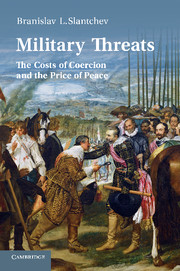Book contents
- Frontmatter
- Contents
- List of figures
- List of tables
- Acknowledgements
- Part I Coercion and Credibility
- Part II A Theory of Military Threats
- Part III Elements of Militarized Deterrence
- 5 Militarization and the Distribution of Power and Interests
- 6 The Expansion of the Korean War, 1950
- 7 The Price of Peace and Military Threat Effectiveness
- Part IV Conclusions
- Appendix A Formalities for Chapter 2
- Appendix B Formalities for Chapter 3
- Appendix C Formalities for Chapter 4
- Appendix D Formalities for Chapter 5
- Bibliography
- Index
6 - The Expansion of the Korean War, 1950
Published online by Cambridge University Press: 03 February 2011
- Frontmatter
- Contents
- List of figures
- List of tables
- Acknowledgements
- Part I Coercion and Credibility
- Part II A Theory of Military Threats
- Part III Elements of Militarized Deterrence
- 5 Militarization and the Distribution of Power and Interests
- 6 The Expansion of the Korean War, 1950
- 7 The Price of Peace and Military Threat Effectiveness
- Part IV Conclusions
- Appendix A Formalities for Chapter 2
- Appendix B Formalities for Chapter 3
- Appendix C Formalities for Chapter 4
- Appendix D Formalities for Chapter 5
- Bibliography
- Index
Summary
The Communists frequently adopt a threatening posture with the cold-blooded purpose of so frightening their enemies that the latter will surrender without a fight.
O. Edmund Clubb, November 7, 1950Although the primary contribution of this study is theoretical, it is worth exploring the implications of the new insights offered by the militarized deterrence model. I do not wish to claim that this model somehow captures “enough” of the strategic interaction during crisis to apply it to any particular event and claim that it fully explains what transpired. My focus has been on clarifying the dynamics of military escalation, and as such I have entirely neglected other factors, such as domestic politics, the structure of the international environment, the potential behavior of third parties, and anticipated consequences of one's actions for future interactions. All of these are important for determining crisis behavior. They can be, and have been, easily accommodated in the rationalist framework. Even traditionally competing approaches such as the organizational or bureaucratic explanations can be incorporated into this framework if we conceive of the domestic structure as a configuration of various interest groups with particular sets of preferences that make up the context of constraints and incentives in which leaders operate. I also happen to think that we have not paid sufficient attention to such factors as considerations of prestige, honor, and emotions such as anger and fear that must be accounted for if we are to gain a good grasp of the phenomenon we wish to study (O'Neill, 1999).
- Type
- Chapter
- Information
- Military ThreatsThe Costs of Coercion and the Price of Peace, pp. 191 - 223Publisher: Cambridge University PressPrint publication year: 2011



